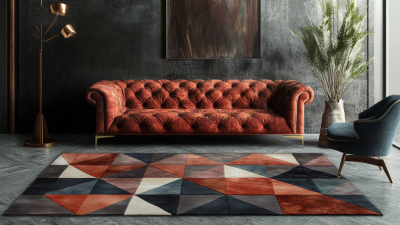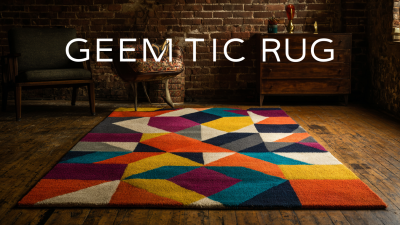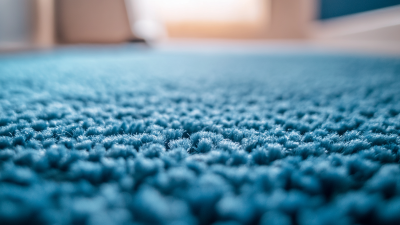
-
Home
-
About Us
-
Products
-
News
-
Blog
-
Contact Us
Leave Your Message

In the ever-evolving landscape of interior design, the impact of geometric rugs has gained unprecedented recognition as a transformative element in home aesthetics. According to a recent report by the Interior Design Association, the market for area rugs, specifically geometric styles, has seen a growth rate of over 15% annually, reflecting their rising popularity among homeowners and designers alike. 
Renowned interior design expert, Dr. Emma Harrison, has emphasized the power of geometric patterns in her work, stating, “Geometric rugs are more than just decoration; they encapsulate a rhythm that can harmonize an entire room.” This insight highlights how the strategic use of geometric rugs can elevate a space, bringing together various design elements and promoting a cohesive atmosphere. With the ability to cater to diverse aesthetics—from minimalist to maximalist—geometric rugs are becoming increasingly integral in shaping contemporary interiors.
As we explore the "Top 10" ways to unlock the potential of geometric rugs, it is crucial to recognize the multifaceted roles they play in enhancing interior design. By integrating these striking pieces, homeowners can achieve a balance of style, comfort, and functionality, ultimately transforming their living spaces into reflections of their personal identities.
Geometric rugs have rapidly gained popularity in modern interior design, offering both aesthetic appeal and versatility. According to a report by the International Floor Covering Association, the demand for patterned rugs, particularly geometric ones, has surged by 25% over the past five years. These rugs are celebrated for their ability to introduce structure and rhythm to a space, making them ideal for contemporary interiors where clean lines and minimalism are emphasized.
The integration of geometric patterns can create a striking focal point, allowing homeowners to express their individual style while maintaining a cohesive design.
Moreover, the visual dynamics of geometric rugs can enhance the overall atmosphere of a room. A study conducted by the American Society of Interior Designers revealed that 67% of interior designers believe that incorporating bold patterns can significantly elevate the mood of a space. Geometric designs are particularly effective in larger areas, where they can anchor the room and add depth.
With various colors and shapes available, these rugs can complement a vast array of furnishings, making them a practical choice for anyone looking to rejuvenate their interior design with style.
When choosing the right geometric rug for your space, it's essential to consider factors such as color, size, and pattern. According to a market report by IBISWorld, the demand for area rugs in the United States has seen a steady growth rate of 4.2% annually, highlighting their importance in home decor. A well-selected geometric rug not only adds visual interest but also acts as a foundation for your interior design.
**Tips:** First, assess the color palette of your room. Geometric patterns often feature a mix of bold colors, which can either complement or clash with existing furnishings. For smaller spaces, opt for lighter shades to create an illusion of openness, while bolder, darker hues can make larger rooms feel cozier.
Secondly, size matters. A rug that’s too small can make a room feel disjointed, whereas an oversized rug can unify the space. The general guideline is to ensure that at least the front legs of your furniture sit on the rug, which helps in anchoring the design. Remember, the right geometric rug can be a focal point that ties together all elements of your room, transforming your overall aesthetic.
Incorporating geometric patterns into your color scheme can significantly elevate your interior design, creating a harmonious and vibrant atmosphere. Geometric rugs, with their bold shapes and lines, serve as perfect anchor pieces, allowing you to play with an array of colors that complement or contrast beautifully. For instance, pairing a striking geometric rug with warm, earthy tones can transform a simple space into a lively hub of creativity. As seen in contemporary trends, designers are gravitating towards bright colors and eye-catching patterns to refresh their home decor, ensuring that every element contributes to a visually striking environment.
Additionally, the versatility of geometric patterns extends beyond rugs to various design elements such as wall art, textiles, and even furniture. This year, integrating playful design elements and modern twists on classic styles, resembling the ongoing influence of mid-century modern aesthetics, can create a balanced and dynamic space. Whether combining geometric shapes with Art Deco glamour or modernizing traditional motifs, the possibilities are endless. Embrace the interplay of colors and patterns to unlock your interior's potential, ultimately enriching your living experience with an unmistakable style.
Geometric rugs have the unique ability to add depth and dimension to any space, creating a striking focal point while enhancing the overall aesthetic. Layering these rugs can transform a flat room into a visually appealing environment. When considering how to layer geometric rugs effectively, it's essential to focus on varying sizes and patterns. Start with a larger, neutral base rug to ground the area, then add a smaller geometric design on top for a pop of visual interest.
One effective tip for layering is to choose rugs with complementary color palettes. This approach maintains harmony while allowing the geometric patterns to stand out. Additionally, consider mixing rug textures—pair a plush geometric rug with a more structured woven piece to create an inviting and dynamic space. Lastly, don't shy away from experimenting with different shapes; combining a circular rug with a rectangular one can break the monotony and draw the eye, enhancing the layered effect.
Geometric rugs can be striking focal points in any room, but maintaining their appearance and longevity is crucial for lasting enjoyment. Given their unique designs and colors, regular care ensures they remain vibrant and stylish. It's important to follow simple maintenance practices, such as vacuuming frequently to remove dirt and debris, and addressing spills promptly to prevent stains. For washable rugs, checking the care labels for specific cleaning instructions can help preserve the texture and colors without compromising the quality.
In real-life tests, various washable rugs have demonstrated their practicality amidst daily challenges, such as those from children and pets. The ease of cleaning has been a standout feature, allowing parents to manage messes effortlessly. However, it's essential to assess how each type holds up after multiple washes. Some rugs retain their shape and color better than others, while certain materials may show wear more quickly. By being attentive to the care requirements specific to your rug, you can enjoy the aesthetic benefits of geometric designs without sacrificing durability.





